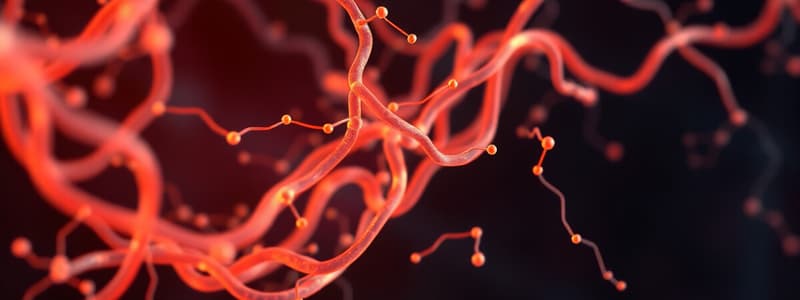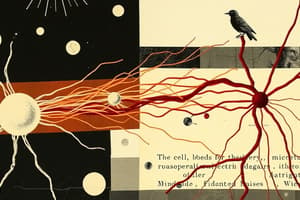Podcast
Questions and Answers
What initiates the branching of actin filaments during cell motility?
What initiates the branching of actin filaments during cell motility?
- Formin assembly
- Talin activation
- ARP binding (correct)
- Integrin formation
Which statement describes the role of myosin in cell motility?
Which statement describes the role of myosin in cell motility?
- Myosin shortens protrusions by sliding actin filaments. (correct)
- Myosin induces filament formation from G actins.
- Myosin stabilizes the leading edge of the cell.
- Myosin binds to actin filaments to prevent their sliding.
What is the primary function of cross-linking proteins such as filamin in actin networks?
What is the primary function of cross-linking proteins such as filamin in actin networks?
- To cap the plus ends of filaments to prevent depolymerization.
- To initiate branching from preexisting filaments.
- To form flexible networks with randomly aligned filaments. (correct)
- To create a rigid network of actin filaments.
In cellular protrusion formation, which protein is responsible for anchoring actin bundles at contact sites?
In cellular protrusion formation, which protein is responsible for anchoring actin bundles at contact sites?
Which aspect of formin's activity is critical for actin filament organization?
Which aspect of formin's activity is critical for actin filament organization?
What role does Rho GTP play in the organization of actin filaments?
What role does Rho GTP play in the organization of actin filaments?
Which mechanism is primarily responsible for the movement of neutrophils towards an attractant?
Which mechanism is primarily responsible for the movement of neutrophils towards an attractant?
How does the binding of ATP affect myosin heads in muscle contraction?
How does the binding of ATP affect myosin heads in muscle contraction?
Which statement correctly describes the role of spectrin in the cytoskeleton?
Which statement correctly describes the role of spectrin in the cytoskeleton?
What is the function of the adhesion belt in epithelial tissues?
What is the function of the adhesion belt in epithelial tissues?
Flashcards are hidden until you start studying
Study Notes
Actin Filaments
- Actin filaments are essential for cell movement, structure, and function.
- Actin filaments are made of globular proteins called G-actin.
- G-actin monomers assemble into long, helical polymers called F-actin.
- Actin filaments have a plus end and a minus end.
- The plus end is where the filament grows, while the minus end is where it shrinks.
- The process of assembling and disassembling actin filaments is crucial for cell movement.
- Actin binding proteins regulate the behavior of actin filaments.
Actin Filament Assembly and Disassembly
- Actin filaments are formed from the polymerization of G-actin.
- ATP is required for actin assembly.
- The assembly of actin filaments is mainly at the plus end.
- Assembly and disassembly of filaments are responsible for changes in cell shape and movement.
Actin Filament Associated Proteins
- ARP2/3 Complex:
- Initiates branching of actin filaments, which is crucial for cell crawling
- Binds to the minus end of actin filaments.
- Cofilin:
- Is involved in the disassembly of actin filaments
- Binds to ADP-actin in filament.
- Profilin:
- Facilitates the exchange of ADP for ATP on G-actin, making it ready for polymerization.
- Formin
- Initiates de novo filament formation.
- Can stay at the growing plus end of the filament, promoting polymerization.
- Formin is regulated by Rho GTPases, which are involved in cell signaling pathways.
Actin Filaments and Cell Movement
- Actin filaments are essential for cell crawling.
- Lamellipodia (thin sheet-like protrusions) and filopodia (thin, finger-like protrusions) are driven by actin filaments.
- Cell crawling involves several steps:
- Extension of protrusions at the leading edge.
- Adhesion of the protrusions to the surface.
- Pulling of the rest of the cell towards the adhesion point.
Supporting Proteins for Cell Movement
- Myosin:
- Motor proteins that bind to actin filaments.
- Myosin I shortens protrusions by sliding actin filaments.
- Myosin II is involved in the contraction of the cell.
- Integrins:
- Adhesion molecules that connect the cell to the extracellular matrix.
- Integrins bind to actin filaments to help the cell move around the matrix.
- Talin:
- A protein that helps integrins to bind to actin filaments.
The Roles of Other Structural Proteins
- Spectrin:
- Is a major cytoskeleton-associating protein that binds to actin filaments.
- Is mainly found underneath the plasma membrane.
- Dystrophin:
- Is a protein that anchors actin filaments to the plasma membrane.
- Mutations in dystrophin are responsible for Duchenne muscular dystrophy.
- α-actinin
- Is required for myosin sliding
- Is a crucial protein for muscle contraction.
- Cadherin:
- Is a cell-cell adhesion protein.
- Cadherins bind to actin filaments, connecting cells together.
Rho Family Proteins
- Rho GTPases are crucial for cell movement and signaling.
- Rho GTPases are involved in the regulation of actin polymerization via formin and ARP2/3 complex.
- One example of this is the attraction of neutrophils to fMetLeuPhe (N-formylmethionine-leucine-phenylalanine).
Studying That Suits You
Use AI to generate personalized quizzes and flashcards to suit your learning preferences.




